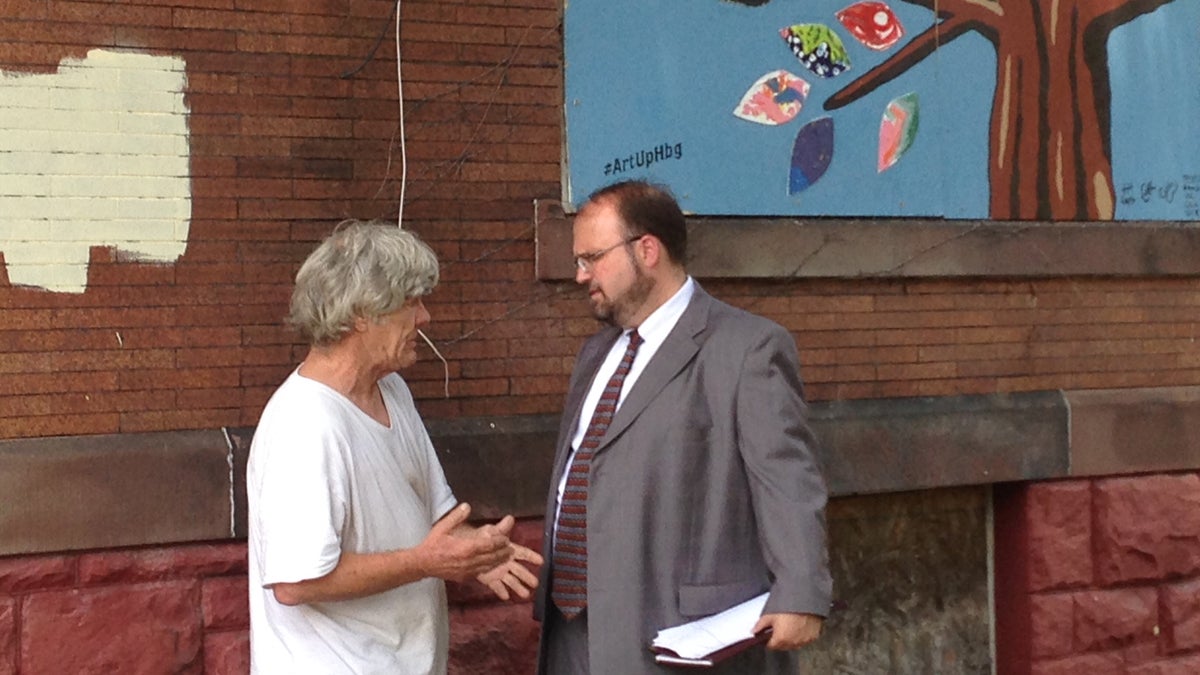Harrisburg fighting blight with public art

Harrisburg Mayor Eric Papenfuse talks with a city resident at an event to highlight an initiative that will board up blighted buildings with artwork. (Emily Previti/WITF)
A new initiative will try to use blight as a vehicle for displaying artwork in Pennsylvania’s capital city.
Instead of plain plywood, paintings by residents will be used this summer to seal doors and windows of 13 vacant buildings in Harrisburg.
This story was first published by partner station WITF in Harrisburg, Pennsylvania.
A new initiative will try to use blight as a vehicle for displaying artwork in Pennsylvania’s capital city.
Instead of plain plywood, paintings by residents will be used this summer to seal doors and windows of 13 vacant buildings in Harrisburg.
The theory: the artwork fosters a stronger sense of ownership and appreciation for the neighborhood in its residents, who then are more likely to report crime or less likely or commit it. Or both.
Tri-County Action’s Executive Director Kathy Possinger says she’s observed a deterrent effect from murals in other parts of Harrisburg and other cities including Philadelphiaand Kansas City, and believes the paintings going up now will go a long way toward preventing crime – including further vandalism to shuttered structures.
The city has the legal authority to tear down many of these properties because they’ve deteriorated to the point that they put public safety at risk – a process that takes years of neglience often accompanied by unpaid real estate taxes and code violation fines.
The time-consuming process of trying to force owners to take responsibility normally is futile as well.
And demolitions cost tens – or hundreds – of thousands of dollars, so the city doesn’t have enough money to tear down more than 30 buildings or so per year.
In the meantime, however, the buildings need to be secured.
The Pennsylvania National Guard’s Counterdrug Joint Task Force has been helping Harrisburg since its launch in 2000, but this year marks the first they’ll use hand-painted boards to do it.
In addition to the Task Force, Tri-County is partnering with city officials, Penn State Harrisburg, and the Dauphin County District Attorney’s Office on the initiative.
Jeff Copus, one of the Penn State graduate students working on the project, says he hopes the endeavor continues in the future.
“This is a project I would like to see grow, as far as using work as a way to reclaim some of this property for the community, and give the community a voice in the artwork,” Copus said.
Residents created their paintings earlier this spring during Multi-Cultural fest in the city’s South Allison Hill section.
Known for being a particularly dangerous and rundown section of Harrisburg, South Allison Hill is the focus area of this new initiative.
Five target properties are on the 1200 block of South 13th Street.
Lettie Allen lives there.
The 52-year-old loathes walking past the dilapidated properties.
They look bad, sure. But they sometimes smell worse, Allen said.
And she said she can only imagine the animals, bugs, drug users and whatever – or whoever – else lurking behind their sagging porches and broken windows.
“It’s just gotta stop somewhere, you know,” she said. “We gotta live around here.”
Allen thinks public art very well could be an effective deterrent and improvement mechanism.
She figures artwork has to be more likely than plywood to give would-be vandals pause, and that residents could be more likely to report something that threatens the newly improved look of their neighborhood.Sgt. Joshua Cesavice agreed.
“If somebody really wants in this building, they can get in the building. It’s just wood. But I’m sure nobody in this community is going to want to see that artwork go down,” said Cesavice, who lives in Harrisburg. “And we’re just trying to make the area nicer to come through. We’re trying to make it not so desolate.”
WHYY is your source for fact-based, in-depth journalism and information. As a nonprofit organization, we rely on financial support from readers like you. Please give today.



